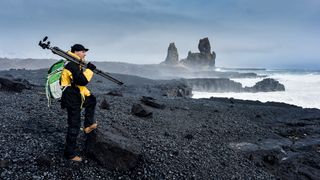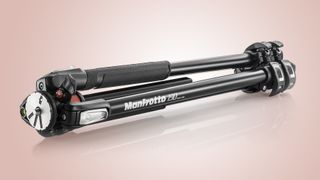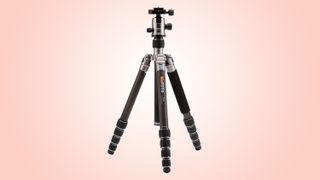Why every photographer needs three tripods
Make sure you have the right support for the job

It’s safe to say that the more interested you become in photography, the more gear you inevitably accumulate. The more you learn, the more you realize that to get the best results you need the right kit for the job in hand, whether that’s lenses, accessories, bags or even clothing. And to that end, we're here to suggest that every photographer should have three tripods. That’s right, three. And no, we haven't gone gear crazy. Bear with us…
Tripods are essential kit regardless of what you shoot. Even if you’re an avid portrait and fashion photographer you may not use a tripod for every shoot, but there will be times where mounting the camera to maintain composition is the best way of working, and doing so can free you to interact with your model without having the camera constantly held up to your face.
If, on the other hand, you’re a landscape, cityscape/architecture or macro photographer, a tripod or some other type of camera support is an absolute necessity. You can of course shoot these subjects handheld, but 90% of the time a tripod will be the best option for ensuring pin-sharp shots.
So here are the three types of tripod we believe every photographer should have at their disposal – it all comes down to stability, size, weight and convenience.
Main tripod: carbon fiber

If you only have one tripod in your life, it should be a full-size a carbon fiber model. You’ll pay more for a set of carbon fiber legs than for their aluminium counterparts – many tripod models are available in both carbon fiber and aluminium – but what you get for your money is a tripod that’s lighter to carry for long periods of time. If, however, your tripod will mostly be used at home or in the studio, then opting for the cheaper aluminium model isn’t a bad idea.
A full-size tripod offers greater stability than smaller and lighter travel models, which is important if you shoot long exposures with the tripod at full height, or if you like to shoot in wide-open windswept landscapes, as there’s less chance of the tripod moving, which could result in blurred images. A full-size tripod will have a greater maximum working height than a travel model, and will be more stable at this height.
When purchasing this type of tripod it’s common to have to select the legs and the head individually. This means you can select the most appropriate type of head for the type of photography you shoot, and to suit your personal preference, plus you’re not confined to a single manufacturer – you can mix and match to get the best combination.
Get daily insight, inspiration and deals in your inbox
Get the hottest deals available in your inbox plus news, reviews, opinion, analysis and more from the TechRadar team.
Second tripod: travel model

So you’ve got your sturdy main tripod, but there will be times when you need to cut down on size and weight. While a full-size carbon fiber tripod doesn’t weigh that much, with a head attached it will still be larger and heavier than a dedicated travel tripod. Travel tripods generally cost £100-£250 / $130-$330 / AU$170-AU$430, and like their full-size counterparts are available in both carbon fiber and aluminium.
A travel tripod will typically weigh less than 1.5kg, have a closed length of around 40cm, a maximum height of around 150cm and a maximum payload of around 4kg. So not only are they light to carry, they’re small enough to fit inside a small suitcase, while they can comfortably support anything from a compact system camera up to a professional DSLR such as a Canon EOS 5D Mark IV or Nikon D850 with a 70-200mm lens attached.
The downside is that you don’t get the stability of a full-size tripod, and will have to take more care to avoid camera movement when the tripod is extended to full height. But the size and weight savings are considerable, and mean that you can travel light knowing you have a camera support capable of carrying the most popular camera and lens combinations. For wildlife photographers, however, their reliance on large and heavy telephoto lenses means a full-size tripod and appropriate head will always be the best option.
Third tripod: the pocket option

Mini tripods have come a long way in recent years, and while some models are extremely basic others offer all the functionality you’d get in a full-size tripod, but in a pocket-sized package. As with travel tripods, the main advantage here is reduced size and weight, and this type of tripod is ideal when even a travel tripod would be too big and heavy, or when you want an almost ground-level viewpoint.
For a mini tripod you can expect to pay anywhere between £20 / $25 / AU$30 and £100 / $130 / AU$170, with the price generally corresponding to the features you get. At the cheaper end the tripod will have tiny fixed legs with a basic ball head, while more expensive options will have much of the functionality of a full size-tripod. Selecting the right one for you will come down to size, weight and maximum operating height.
These tripods really are take-anywhere options, and perfect for those times when you don’t think you’ll need a tripod, but want to bring one just in case. The main downside is that the maximum payload will only be around 2kg, while maximum height will range from around just 20cm to 50cm, so you may have to be creative with where you position the tripod if you need more height. On the plus side, however, a tripod this low to the ground can provide some interesting viewpoints.
A final thought
So, if the idea of owning three tripods sounds excessive initially, once you consider how each option can enhance your photography in its own way you'll see that it makes a good deal of sense. It’s a lot like camera bags really – most photographers have two or three for different scenarios. With tripods it all comes down to what you’re able to carry in any given situation, balanced against how much stability you need. There will always be times where you have to use a larger and heavier tripod than you’d like, but nothing beats having the option to lighten your load if possible.
James Abbott is a professional photographer and freelance photography journalist. He contributes articles about photography, cameras and drones to a wide range of magazines and websites where he applies a wealth of experience to testing the latest photographic tech. James is also the author of ‘The Digital Darkroom: The Definitive Guide to Photo Editing’.
Most Popular





